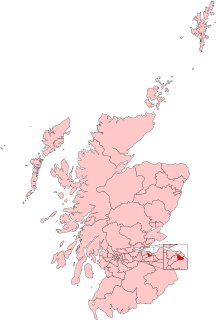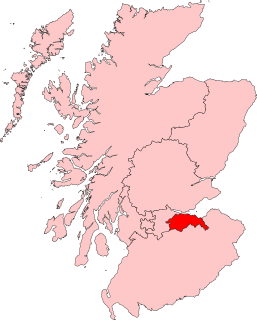The politics of Edinburgh are expressed in the deliberations and decisions of the City of Edinburgh Council, in elections to the council, the Scottish Parliament, the House of Commons and the European Parliament.
Local government in Scotland is organised through 32 unitary authorities designated as councils which consist of councillors elected every five years by registered voters in each of the council areas.

Edinburgh South is a constituency of the House of Commons of the UK Parliament created in 1885. The constituency has been represented by the Labour Party's Ian Murray since 2010. Murray was the only Labour MP in Scotland to retain his seat at the 2015 general election, and did so with an increased majority, where he result rendered it the 23rd-most marginal Labour seat by percentage of majority nationwide.

Edinburgh East is a burgh constituency of the House of Commons of the Parliament of the United Kingdom. It elects one Member of Parliament (MP) by the first past the post system of election.

Edinburgh Pentlands is a constituency of the Scottish Parliament. It elects one Member of the Scottish Parliament (MSP) by the plurality method of election. It is one of nine constituencies in the Lothian electoral region, which elects seven additional members, in addition to nine constituency MSPs, to produce a form of proportional representation for the region as a whole.

Edinburgh South West is a Scottish constituency of the House of Commons of the Parliament of the United Kingdom (Westminster), first used in the 2005 general election. It elects one Member of Parliament (MP) by the first past the post system of election.

Edinburgh North and Leith is a constituency of the House of Commons of the Parliament of the United Kingdom, first used in the 1997 general election. It elects one Member of Parliament (MP) by the first past the post system of election.

Edinburgh Central was a burgh constituency of the House of Commons of the Parliament of the United Kingdom from 1885 to 2005. It elected one Member of Parliament (MP) by the first past the post system of election.
A bailie or baillie is a civic officer in the local government of Scotland. The position arose in the burghs, where bailies formerly held a post similar to that of an alderman or magistrate. Modern bailies exist in Scottish local councils, with the position being a courtesy title and appointees often requested to provide support to the Lord Provost or Provost - the ceremonial and civic head of the council - in their various engagements.

Edinburgh Central is a burgh constituency of the Scottish Parliament (Holyrood). It elects one Member of the Scottish Parliament (MSP) by the plurality method of election. Also, it is one of nine constituencies in the Lothian electoral region, which elects seven additional members, in addition to nine constituency MSPs, to produce a form of proportional representation for the region as a whole.

Elections to the City of Edinburgh Council were held on 3 May 2007 the same day as the Scottish Parliament general election. The election was the first one using 17 new wards created as a results of the Local Governance (Scotland) Act 2004, each ward will elect three or four councillors using the single transferable vote system a form of proportional representation. The new wards replace 58 single-member wards which used the plurality system of election.

There were elections for the Scottish district councils in 1977.
Sheila Gilmore is a British Labour Party politician, who was the Member of Parliament (MP) for Edinburgh East from 2010 to 2015. Gilmore stood for the seat following the decision of Gavin Strang to stand down; she is a former City of Edinburgh councillor.

Edinburgh Eastern is a constituency of the Scottish Parliament (Holyrood). It elects one Member of the Scottish Parliament (MSP) by the plurality method of election. Also, however, it is one of nine constituencies in the Lothian electoral region, which elects seven additional members, in addition to nine constituency MSPs, to produce a form of proportional representation for the region as a whole.

The City of Edinburgh Council is the local government authority for the City of Edinburgh. It was created in 1996 under the Local Government etc. (Scotland) Act 1994, with the boundaries of the post-1975 City of Edinburgh district of the Lothian region.

There were elections for the Scottish district councils in 1980.

Elections to the City of Edinburgh Council were held on 1 May 2003, the same day as the other Scottish local government elections and the Scottish Parliament general election.

Elections for the City of Edinburgh District Council took place on Thursday 3 May 1984, alongside elections to the councils of Scotland's various other districts.
Elections for the City of Edinburgh District Council took place in 1974, alongside elections to the councils of Scotland's various other districts. These was the first election to the City of Edinburgh District Council, and saw the Conservatives winning 30 of the Councils 64 seats.

Elections to the City of Edinburgh Council were held on 6 May 1999, the same day as the other Scottish local government elections and the Scottish Parliament general election. Turnout was 61%, an increase of 16.5% on the 1995 turnout.











